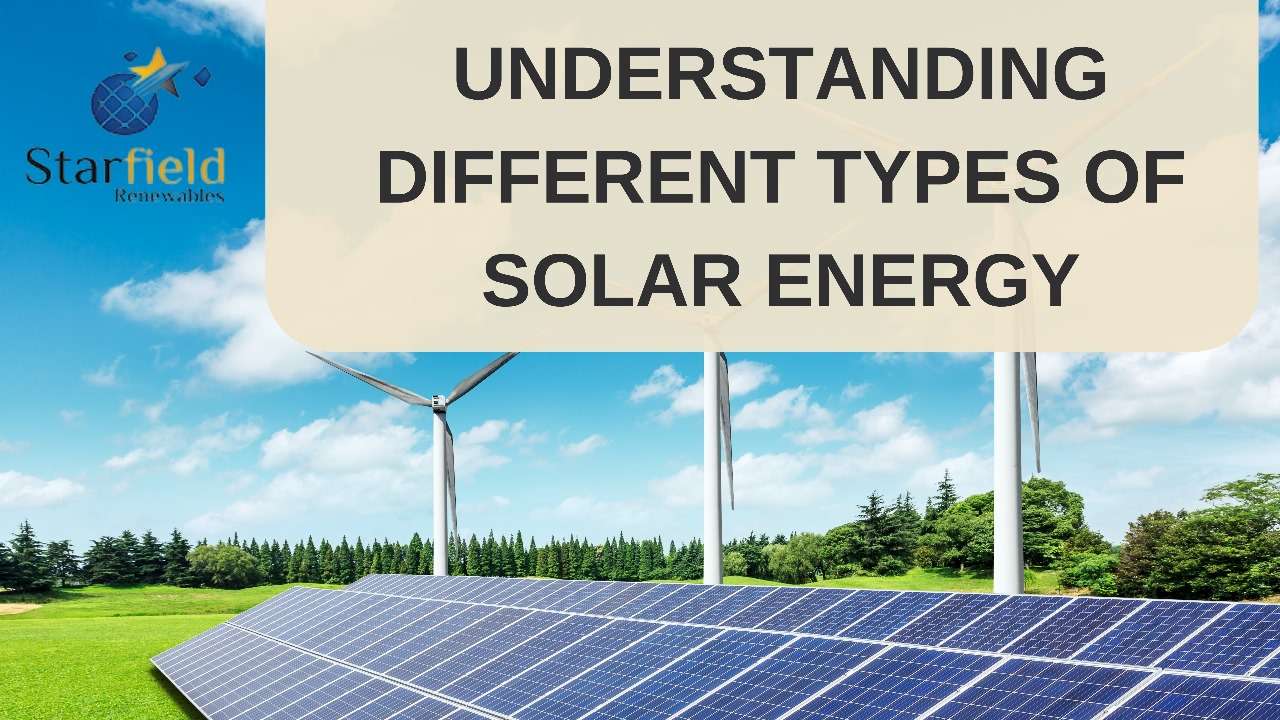Solar energy from the sun’s rays is a renewable resource that plays a vital role in our quest for sustainable and clean energy solutions. As concerns about climate change and environmental degradation grow, understanding the different types of solar energy becomes even more important.
At a time when our responsibility to our planet and the environment is a top priority, it’s important to know what solar energy is, how it works, and how to increase its use as a source of power generation. In this article, we’ll explore the four main types of solar energy.
Understanding Solar Energy: More Than Meets the Eye
Solar energy is a broad term that includes a variety of technologies that harness the power of the sun. Although it is often simplified, it is important to recognize the versatile nature of this energy source. Solar energy comes from the sun in the form of electromagnetic radiation (light, heat and ultraviolet rays). By installing solar panels or collectors, it can be used to capture thermal energy (photothermal) or to generate electricity (photovoltaic).
What Types of Solar Energy Are There?
Learn about the different types of solar energy – photovoltaic, CSP & solar thermal. Learn about their benefits, applications and prospects in this brief blog.
1. Photovoltaic Solar Energy (PV)
Photovoltaic solar energy, commonly known as PV, is one of the most widely used forms of solar energy. It was discovered in 1839 by French physicist Edmond Becquerel and was first used in industrial applications in 1954.
Photovoltaic solar energy is obtained by converting sunlight (solar radiation) into electricity through the use of solar panels, a technology based on the photoelectric effect. Solar panels contain photovoltaic cells that convert sunlight into direct current (DC) electricity.
Components of PV Systems
- Solar Panels: Capture sunlight and convert it into electricity.
- Inverters: Convert direct current (DC) electricity into alternating current (AC) for use in homes and businesses.
- Mounting Systems: Secure solar panels in place on rooftops or ground installations.
- Batteries: Store excess energy for use during non-sunny periods (optional).
Types of PV Cells
- Monocrystalline: Made from a single crystal structure, offering high efficiency.
- Polycrystalline: Made from multiple crystal structures, offering a balance of efficiency and cost.
- Thin-Film: Made from layers of semiconductor materials, offering flexibility and lightweight options.
Applications of PV Systems
- Residential and commercial electricity generation.
- Powering remote and off-grid locations.
- Integrating into building materials (BIPV).
2. Concentrated Solar Power (CSP)
This second type of thermal solar energy technology concentrates the heat of the sun’s rays using collectors to heat a transfer fluid (for example gas, oil or molten salt) to high temperatures. This fluid heats a network of water, which produces steam, which can generate electricity through steam turbines or engines.
This process can be repeated continuously because CSP technology can store the heat produced. It can therefore be used on days when there is no sun, or before sunrise and after sunset. This technology is most suitable for countries where sunlight is intense, for example in desert areas.
Types of CSP Technologies
- Parabolic Troughs: Use curved mirrors to focus sunlight onto a receiver tube.
- Solar Power Towers: Use a field of mirrors to concentrate sunlight onto a central tower.
- Fresnel Reflectors: Use flat mirrors to focus sunlight onto a receiver tube.
- Dish Stirling: Use parabolic dishes to concentrate sunlight onto a Stirling engine.
Applications of CSP Systems
- Large-scale power plants.
- Industrial process heat.
- Desalination of seawater.
3. Solar Thermal Energy
Solar thermal energy is energy created by converting solar energy into heat and is one of the most cost-effective forms of using solar energy. Solar thermal energy systems capture and use the sun’s heat for various applications, such as water heating, space heating and industrial processes. Most commonly, the energy is used for low-temperature applications such as hot water for laundry, space heating, supplying heat to district heating networks or providing heat to industrial processes.
Types of Solar Thermal Systems
- Low-Temperature: Used for applications like swimming pool heating.
- Medium-Temperature: Used for domestic hot water and space heating.
- High-Temperature: Used for electricity generation and industrial processes.
Components of Solar Thermal Systems
- Solar Collectors: Capture and transfer heat from sunlight.
- Storage Tanks: Store heated water or other fluids for later use.
- Heat Exchangers: Transfer heat from the collector to the water or space being heated.
Applications of Solar Thermal Systems
- Residential water and space heating.
- Industrial process heating.
- Solar cooling and air conditioning.
4 – Passive Solar Energy
Passive solar energy is a free, untapped resource. Sunlight entering through windows can provide up to 14% of a UK home’s heating needs. The smart design maximises this, often at no extra cost.
This involves capturing sunlight through large windows, storing the heat in materials such as brick or concrete, and releasing it slowly. Passive cooling uses the same principles to keep buildings cool in summer. It is an important part of sustainable architecture.
Latest Innovations in Solar Energy
Advancements in PV Technology
- Bifacial Solar Panels: Capture sunlight on both sides, increasing energy output.
- Perovskite Solar Cells: Offer high efficiency and lower production costs.
- Organic Photovoltaics: Flexible and lightweight, suitable for various applications.
Innovations in CSP Technology
- Molten Salt Storage: Improves energy storage efficiency and stability.
- Advanced Reflector Designs: Enhance sunlight concentration and system performance.
- Hybrid CSP Systems: Combine CSP with other renewable technologies for improved efficiency.
New Applications and Integrations
- Building-Integrated Photovoltaics (BIPV): Integrate solar panels into building materials like windows and roofs.
- Agrivoltaics: Combine solar energy generation with agriculture, optimizing land use.
- Solar-Powered Desalination: Use solar energy to convert seawater into fresh water.
Future Prospects of Solar Energy
- Growth Projections: The solar industry is expected to continue growing rapidly.
- Emerging Markets: Developing countries are increasingly adopting solar energy.
- Policy and Regulatory Landscape: Government policies and incentives will play a crucial role in solar energy adoption.
- Next-Generation Solar Cells: Research is ongoing to develop more efficient and cost-effective solar cells.
- Advanced Energy Storage Solutions: Innovations in battery technology will enhance solar energy storage capabilities.
- Smart Grid and IoT Integration: Integrating solar energy with smart grids and IoT technology will improve energy management.
- Recycling and Disposal of Solar Panels: Developing sustainable methods for recycling and disposing of solar panels is essential.
- Lifecycle Assessment: Evaluating the environmental impact of solar systems throughout their lifecycle.
- Sustainable Manufacturing Practices: Adopting eco-friendly practices in the production of solar panels.
Comparative Analysis of Solar Energy Technologies
Comparison of PV and CSP
- Efficiency and Performance: PV systems are more suitable for small-scale applications, while CSP is ideal for large-scale power generation.
- Cost and Economics: PV systems typically have lower upfront costs, but CSP can offer higher efficiency for large installations.
- Applications and Suitability: PV is versatile and widely used, while CSP is best suited for sunny regions with large land areas.
Comparison of Different PV Technologies
- Monocrystalline vs. Polycrystalline: Monocrystalline cells offer higher efficiency, but polycrystalline cells are more cost-effective.
- Thin-Film vs. Traditional PV: Thin-film is flexible and lightweight, while traditional PV offers higher efficiency.
- Emerging PV Technologies: Innovations like perovskite and organic photovoltaics are promising for future applications.
Comparison of Solar Thermal and PV
- Use Cases and Applications: Solar thermal is used for heating applications, while PV is used for electricity generation.
- Efficiency and Performance: PV systems are generally more efficient for electricity generation, but solar thermal is effective for heating.
- Cost and Maintenance: Solar thermal systems can be more cost-effective for heating, but PV systems have lower maintenance requirements.
How to Choose the Right Solar System
- Assessing Energy Needs: Determine your energy consumption to choose the appropriate system size.
- Evaluating Site and Location: Consider factors like sunlight exposure and available space.
- Comparing Costs and Benefits: Analyze the upfront costs and long-term savings of different systems.
Solar Energy: A Renewable Resource
A defining characteristic of solar energy is its renewability. Unlike fossil fuels, which are finite resources, the sun’s energy is perpetually replenished. This inexhaustible nature makes solar energy a cornerstone of sustainable development and a crucial component in mitigating climate change.
Conclusion: Solar Energy
Solar energy isn’t just a buzzword; it represents a paradigm shift in the way we energize our world. Understanding the many ways we can harness the sun’s energy can unleash its full potential and help us build a cleaner, more sustainable future. The future of solar energy looks promising, with significant growth and innovation expected as technology advances.

